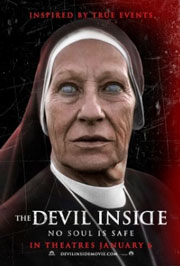The Devil Inside is a shocking exploitation of demonic possession, using the trendy hand-held camera technique to validate its authenticity and re-enforce its savage realism.
You may think that you know all about exorcism movies if you've seen The Exorcist (the 1973 classic by which all other exorcism movies are judged), as well as all the documentary-style possession-and-expulsion chillers of recent years, but exorcism became mass entertainment when the Yiddish The Dybbuk was released 36 years before The Exorcist.
Another documentary-style tale
The Devil Inside is another documentary-style tale, centring on a young woman trying to determine whether her mother, who killed three people while undergoing an exorcism, is clinically insane or really possessed.
The seed for the tired docu-drama and realism infusion in contemporary films was planted by The Blair Witch Project, which poisoned the sensibility of audiences with its brutal visceral onslaught and evolved into several imitations that were either doomed from the outset or were masterfully crafted to supersede its endless possibilities.
The hand-held phenomenon was brilliantly explored in the enormously successful Paranormal Activity saga, the first-rate Cloverfield, and upgraded with the inventive Chronicle.
Unfortunately, this technique loses its impact and uniqueness if it becomes too obvious or, as with films like Project X, filmmakers seem to be convinced that if they make a film that seems real, it will be real, and its constructed reality will result in box office gold.
The hitch is that if it is only used for effect to enhance the context, as with The Devil Inside, or to boost its content (with Project X), its affect is severely impacted and watered down. It becomes intrusive to the storytelling and irritating to its viewers.
A joke to certain viewers
Being manipulated to excess is a fine art form that needs craft and cunning storytelling to be effective and enthralling. If not, as with certain horrific moments in The Devil Inside, it becomes a joke to certain viewers, where laughter destroys the fear and reduces the impact; this clearly shows how the formula has worn off and becomes passé.
If used effectively and skillfully (mostly minimally), as with the opening of The Texas Chainsaw Massacre (2003), Shortbus or American Beauty, its power is indisputable and amplifies the context and content magnificently.
The resonance and relevance of The Devil Inside is also compromised by a subject matter, which has been explored by various filmmakers.
Despite its shortcomings, The Devil Inside is a frightening experience that is shocking disturbing, so sensitive viewers be warned. If you are looking for hard core escapism, this is definitely it.
The ABC of exorcism films
One of the first movies about an exorcism, if not the first, was 1937's The Dybbuk, filmed 36 years before The Exorcist. Based on the celebrated Yiddish play by S Ansky, it's one of the only exorcism movies that draws upon Jewish lore (including Kabbalah mysticism) rather than Catholic traditions. Shot in Poland, the Yiddish-language film tells the story of a bride possessed on her wedding day by the tormented spirit (the "dybbuk" of the title) of the man to whom she was betrothed before her current groom. Brush up on exorcism films and read an interview with the filmmakers at www.writingstudio.co.za/page3986.html


























